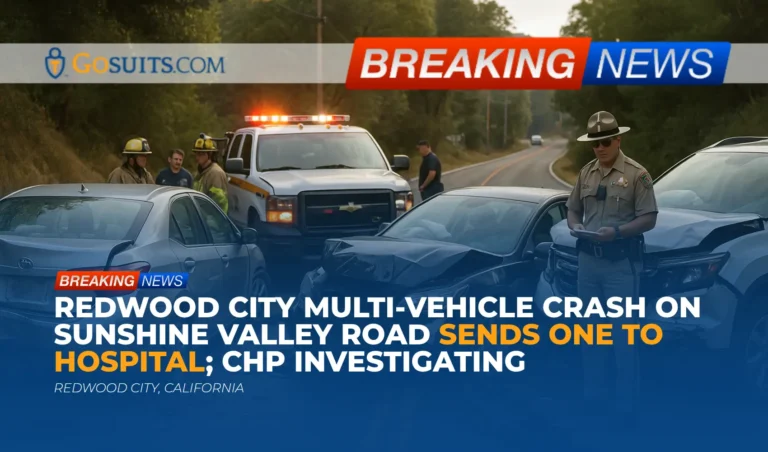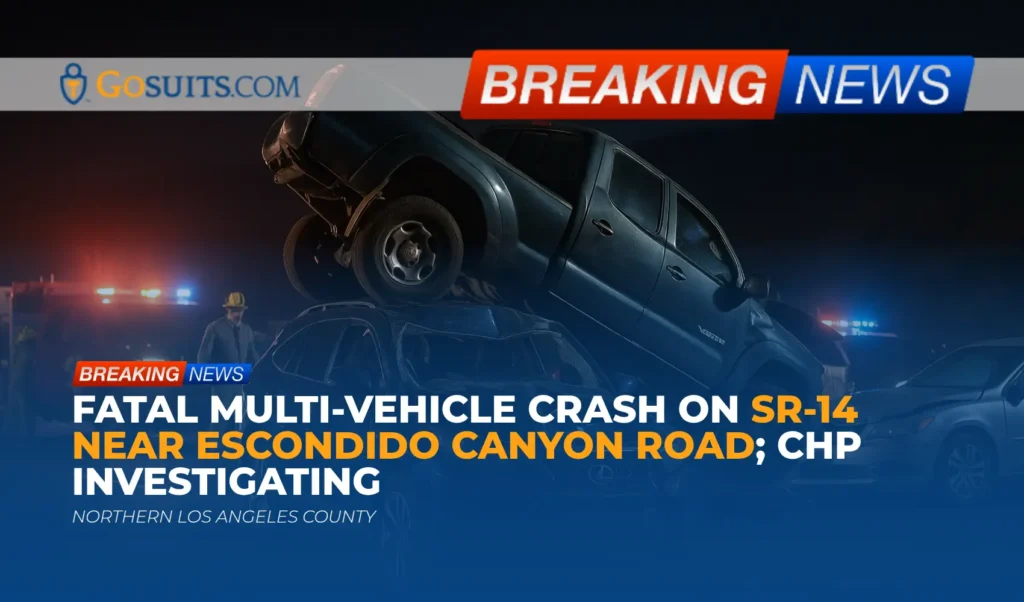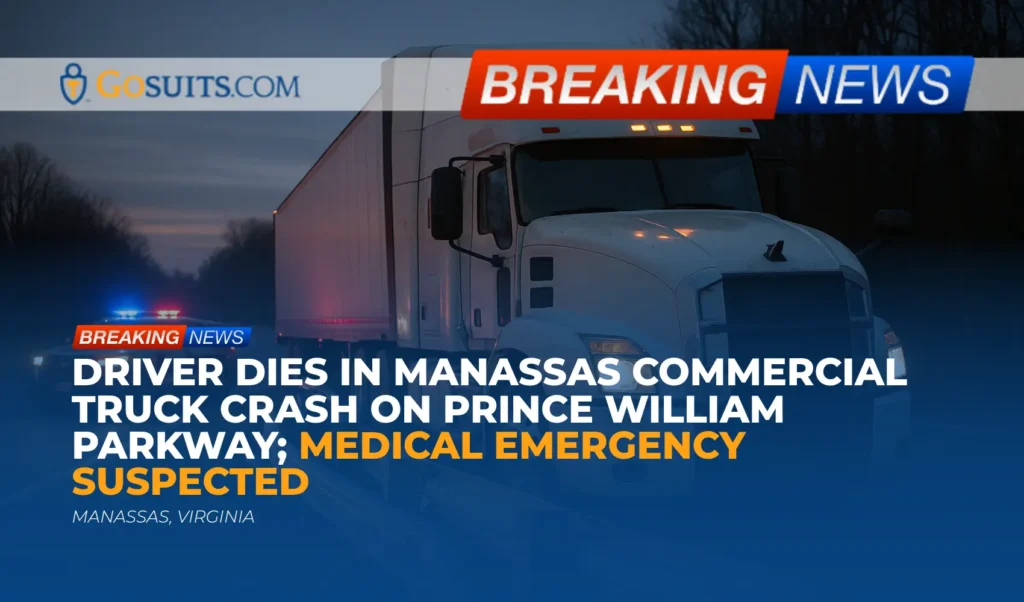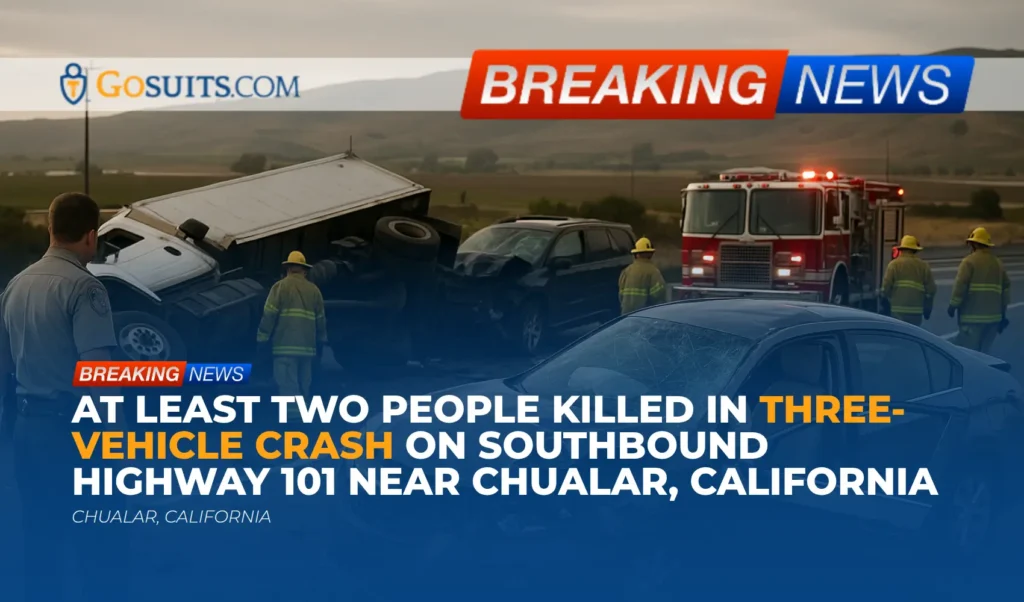- What is known about the Sunshine Valley Road traffic collision
- Immediate steps to consider after a multi-vehicle crash
- How to obtain official records and reports
- Medical care and follow-up after the collision
- Potential civil liability and insurance considerations in California
- If a loved one suffered serious harm or passed away
- Traffic safety context in Redwood City and San Mateo County
- Public agencies and places to call for help
- Commentary from Gosuits Redwood City, California Personal Injury Attorney
- Action steps and why timing matters
- Sources
What is known about the Sunshine Valley Road traffic collision
Emergency responders were dispatched to a traffic collision near 1432 Sunshine Valley Road in Redwood City at approximately 5:30 PM on October 4, 2025. The California Highway Patrol and local emergency services responded promptly. Early information indicates multiple vehicles may have been involved. At least one person was transported to Sequoia Hospital for medical evaluation. The full extent of injuries and property damage has not yet been publicly confirmed, and a formal investigation is ongoing.
Traffic in the surrounding area was significantly affected while responders assisted those involved and cleared the roadway. Investigators are working to reconstruct what happened, gather statements, and review any available physical evidence from the scene. It is common in multi-vehicle collisions for fault and contributing factors to remain unclear until the collision report and related findings are complete.
Immediate steps to consider after a multi-vehicle crash
Health and safety come first
After any crash, the priority is medical care. Some injuries are not immediately obvious at the scene. Conditions such as concussions, internal trauma, and soft-tissue injuries may develop or become more noticeable hours or days later. Prompt evaluation and follow-up with a healthcare professional can protect health and create a clear record of symptoms, diagnostics, and treatment plans.
Document what you can, when it’s safe
If it can be done safely and without interfering with emergency operations, consider documenting details that can later help clarify what happened. Examples include:
- Scene photos and video capturing vehicle positions, roadway markings, debris, skid or yaw marks, nearby signs, traffic controls, and weather or lighting conditions.
- Vehicle details including license plates, visible damage, and any aftermarket modifications that may be relevant.
- Witness information such as names and contact details of bystanders who saw the events leading up to impact.
- Personal notes about what you recall before, during, and after the collision while memories are fresh.
Understand California’s accident reporting requirement to DMV
California law requires parties to report a traffic collision to the DMV within 10 days if anyone was injured or killed, or if property damage appears to exceed the statutory threshold. The DMV’s SR-1 form is used for this purpose and is required even if law enforcement took a report. The DMV does not determine civil fault, but failing to file can affect driving privileges. See the DMV’s Accident Reporting Requirements and SR-1 information for details.
Preserve evidence
Evidence can be lost quickly. Vehicles may be repaired or totaled, roadway markings can fade, and digital data may overwrite. When possible, preserve:
- Vehicle condition before repairs or salvage. Keep the vehicle accessible for inspection until insurance and potential claims are addressed.
- Event Data Recorder (EDR) information from modern vehicles, which can capture speed, braking, and other pre-crash parameters.
- Personal devices (dashcam footage, phone photos, and location data) that may bear on the sequence of events.
- Medical records including ER visits, imaging, prescriptions, and therapy recommendations.
If there is a possibility of a claim, consider asking a qualified attorney to help issue timely preservation requests to involved parties and insurers so relevant evidence is not destroyed.
How to obtain official records and reports
CHP collision report
Because the California Highway Patrol reportedly responded, the primary collision report is typically maintained by the CHP Area Office with jurisdiction over the scene. People directly involved, their legal guardians, or authorized representatives may request a copy. In general:
- Identify the correct CHP Area Office that handled the incident. The CHP’s “Find an Office” tool can assist with locating the appropriate office.
- Submit a request using the CHP’s collision report procedures (commonly by completing Form CHP 190, providing valid identification, proof of involvement, and the incident date/location).
- Expect processing time while the report is completed and approved. Photos or supplemental materials, if any, may require separate requests or fees.
Obtaining the official report can be vital for insurance claims and understanding the investigating officer’s findings, diagrams, and listed contributing factors.
DMV accident report (SR-1)
If the collision involved injury, loss of life, or qualifying property damage, California’s DMV requires filing the SR-1. The filing is separate from any law enforcement report and asks for insurance details. Additional guidance is available through the DMV’s official page on accident reporting.
911 audio, traffic cameras, and other public records
Depending on the location, other records may exist:
- 911 call audio and CAD logs may be obtainable under the California Public Records Act, subject to exemptions for privacy and ongoing investigations.
- Public works signals or maintenance records may exist if there are questions about signal timing, signage visibility, or roadway conditions.
- Body-worn camera or dashcam footage from responding agencies may be subject to statutory rules and redactions.
When making a public records request, be as specific as possible about the date, time, location, and type of record sought. The California Attorney General provides an overview of the Public Records Act and how agencies generally process such requests.
Medical care and follow-up after the collision
Those evaluated at the scene or transported to Sequoia Hospital should follow discharge instructions and seek follow-up care as recommended. If symptoms change or worsen, return for urgent evaluation. Keep copies of all records, bills, and referrals. These records help doctors coordinate treatment and can later document the injury trajectory for insurance or potential claims.
Common post-crash issues include headaches, neck or back pain, dizziness, numbness, and mood or sleep changes. Traumatic stress reactions are also common; counseling and support can help. It is both reasonable and important to talk openly with a provider about physical and emotional symptoms after a collision.
Potential civil liability and insurance considerations in California

What might be investigated
In multi-vehicle incidents, investigators and insurers typically examine a range of factors without presuming fault:
- Speed and following distance relative to traffic and roadway conditions.
- Right-of-way and traffic control compliance, including signals, stop signs, or yield requirements.
- Driver attention and impairment, including distraction or fatigue indications.
- Roadway environment such as lighting, weather, construction zones, or sightline obstructions.
- Mechanical issues including brake function, tire condition, or unexpected failures.
Evidence like scene measurements, vehicle inspections, EDR downloads, and witness statements often shape findings and apportionment of responsibility.
Comparative fault in California
California follows a comparative fault system that allows financial responsibility to be divided among parties based on their percentage of fault. Even when multiple drivers share responsibility, injured people may still seek compensation reduced by their assigned share of fault. The specific time limit to file most personal injury claims arising from negligence is generally two years from the date of injury under state law.
Insurance interactions: proceed carefully
Insurers usually open liability and property damage claims promptly and often request recorded statements. It is appropriate to collect claim numbers and mailing information, but consider speaking with a qualified attorney first, particularly before providing statements that could be used to dispute liability or minimize injuries later. Be cautious with:
- Recorded statements requested early in the process when facts and medical diagnoses may be incomplete.
- Broad medical authorizations that may open unrelated history to scrutiny.
- Quick settlement offers made before the full scope of injury, treatment, and future care is known.
Property damage claims, rental reimbursement, and total loss valuations are often resolved sooner than bodily injury claims. Keep receipts and track all out-of-pocket costs related to the collision.
If a loved one suffered serious harm or passed away
Coroner and autopsy information
When a death is involved, the county coroner typically investigates. For incidents in the Redwood City area, the San Mateo County Coroner is responsible for determining cause of death and safeguarding decedents’ personal property. Next of kin can inquire about autopsy status, obtaining a coroner’s report, and the release process for arrangements. The county maintains a public-facing page for the Coroner’s Office with contact information and procedures.
Death certificates and official documents
Certified death certificates are generally issued by the county’s vital records office. Families can request copies for estate matters, insurance, and benefits. The San Mateo County website provides information about obtaining vital records; review the county’s official site for details on identification, eligibility, and fees.
Financial assistance for eligible victims’ families
California’s Victim Compensation Board may offer support to eligible victims of crime-related incidents, including assistance with funeral and burial expenses when the statutory criteria are met. Review program eligibility and application requirements on the state’s official site.
Traffic safety context in Redwood City and San Mateo County
While the cause of this specific collision remains under investigation, it is helpful to consider broader safety trends. Statewide, transportation agencies track injury and fatal collisions to inform enforcement and engineering priorities. The California Office of Traffic Safety publishes city and county crash rankings with filters for factors such as speed, alcohol involvement, pedestrian and bicycle collisions, and time of day. These resources help communities identify where risks are elevated and which behaviors contribute most to harm.
Nationally, traffic deaths have been a persistent concern. Federal safety officials reported substantial fatality counts in recent years, underscoring the importance of safe speeds, sober driving, and attentive behavior behind the wheel. Local and state initiatives continue to aim at reducing serious crashes through a combination of design, education, and enforcement.
Public agencies and places to call for help
- Emergency: Call 911 for urgent medical or safety needs.
- California Highway Patrol: For non-emergency inquiries about the incident response, the CHP maintains statewide contact information and Area Offices. The CHP’s site also provides access points for collision report requests through the handling Area Office.
- California DMV: Information and forms for reporting qualifying accidents (SR-1) are on the DMV’s official website.
- San Mateo County Coroner: The county’s official page provides contact and process information for coroner reports, identification, and release procedures.
- San Mateo County Public Works: To report or inquire about roadway maintenance, signage, or hazard concerns on county-maintained roads, visit the county’s Public Works site.
If you are unsure which agency has jurisdiction over a particular roadway segment, the CHP Area Office can typically advise which public entity maintains the road and which law enforcement agency prepared the collision report.

Commentary from Gosuits Redwood City, California Personal Injury Attorney
Our thoughts are with everyone affected by the crash on Sunshine Valley Road. Collisions like this are frightening and disruptive, and we recognize the uncertainty families feel while waiting for official findings. This commentary is intended for general education and should not be taken as direction for a particular case.
Based on the early facts, investigators will likely examine speed, following distance, traffic control compliance, driver attention, and the roadway environment. Multi-vehicle collisions can involve layered causes, and it is not unusual for the final report to assign responsibility among more than one driver. Thorough documentation, prompt medical evaluation, and preservation of vehicle data can be pivotal in clarifying what happened and why.
In our experience, insurance companies and large corporations often move quickly to protect their interests. Adjusters may seek recorded statements before the full picture is known, or present early offers that do not account for ongoing treatment, future medical needs, or lost income. People navigating this process for the first time may not realize how statements can be used later to dispute liability or minimize injuries. Taking time to understand rights and the claims process can make a meaningful difference.
A free consultation with a seasoned personal injury attorney can help clarify options, claim timelines, and what evidence matters most. It is a chance to ask questions at no cost, understand how comparative fault might apply, and learn how to avoid common pitfalls in dealing with insurers. Even if someone decides not to move forward with representation, an initial conversation can provide helpful context for the next steps.
Action steps and why timing matters
- Prioritize medical care: Seek evaluation right away and follow through on recommended treatment. Early documentation connects symptoms to the collision and supports safe recovery.
- Preserve evidence promptly: Save photos, dashcam files, damaged property, and receipts. Request that vehicles are not destroyed or repaired until all insurers have inspected them.
- Request official records: Obtain the CHP collision report when available, along with any supplemental materials. Clear documentation is often central to liability and insurance decisions.
- Be cautious with insurers: Consider consulting an attorney before giving recorded statements or signing broad medical releases. What is said early can affect outcomes later.
- Meet legal and administrative deadlines: California’s DMV reporting rules and civil claim deadlines can be strict. Acting within the required timeframes preserves options.
- Track every cost: Maintain a simple file with medical bills, prescriptions, mileage to appointments, lost work time, and repair or replacement expenses. Good records help prevent underpayment.
Acting sooner rather than later reduces the risk of lost evidence, missed healthcare windows, and expired filing periods. It also gives more time to coordinate with insurers, explore recovery options, and plan for any necessary long-term care.
Sources
- California Highway Patrol – Find an Office
- California Highway Patrol – Contact CHP
- California DMV – Traffic Accident Reporting Requirements (SR-1)
- California Code of Civil Procedure § 335.1 (time to sue for injury/wrongful death)
- California Office of Traffic Safety – Crash Rankings
- NHTSA – Early Estimates of 2023 Traffic Fatalities
- NHTSA – Event Data Recorders (EDRs)
- California Attorney General – Public Records Act Overview
- San Mateo County – Coroner’s Office
- San Mateo County – Public Works
- California Victim Compensation Board (CalVCB)






